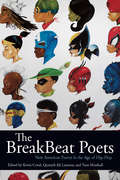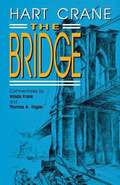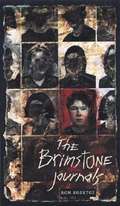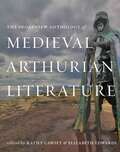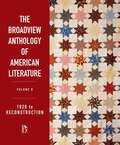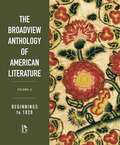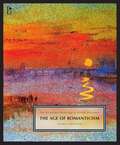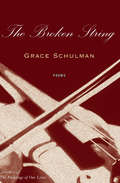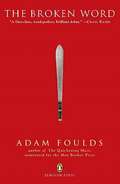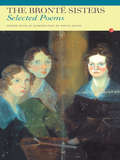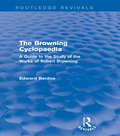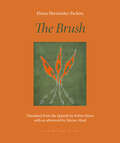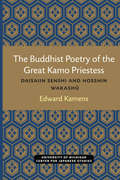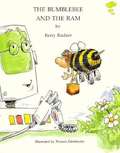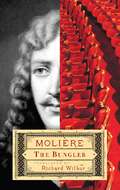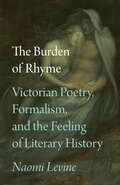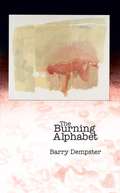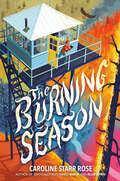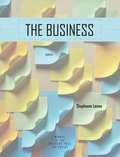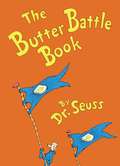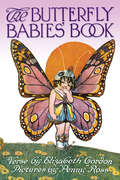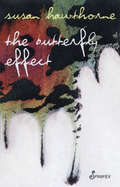- Table View
- List View
The BreakBeat Poets
by Kevin Coval Nate Marshall Quraysh Ali LansanaHip-Hop is the largest youth culture in the history of the planet rock. This is the first poetry anthology by and for the Hip-Hop generation.It has produced generations of artists who have revolutionized their genre(s) by applying the aesthetic innovations of the culture. The BreakBeat Poets features 78 poets, born somewhere between 1961-1999, All-City and Coast-to-Coast, who are creating the next and now movement(s) in American letters.The BreakBeat Poets is for people who love Hip-Hop, for fans of the culture, for people who've never read a poem, for people who thought poems were only something done by dead white dudes who got lost in a forest, and for poetry heads. This anthology is meant to expand the idea of who a poet is and what a poem is for.The BreakBeat Poets are the scribes recording and remixing a fuller spectrum of experience of what it means to be alive in this moment. The BreakBeat Poets are a break with the past and an honoring of the tradition(s), an undeniable body expanding the canon for the fresher.
The Bridge
by Hart CraneBegun in 1923 and published 1930, The Bridge is Crane's major work. "Very roughly," he wrote a friend, "it concerns a mystical synthesis of 'America' ... The initial impulses of 'our people' will have to be gathered up toward the climax of the bridge, symbol of our constructive future, our unique identity."
The Brimstone Journals
by Ron KoertgeIn a series of short interconnected poems, students at a high school nicknamed Brimstone reveal the violence existing and growing in their lives.
The Broadview Anthology Of Medieval Arthurian Literature
by Elizabeth Edwards Kathy CawseyThis teaching anthology collects texts from the vast archive of medieval Arthurian literature. It includes selections from mainstream canonical authors, such as Geoffrey of Monmouth and Sir Thomas Malory, and more peripheral works, such as the Melech Artus (a twelfth-century Hebrew text) and the Dutch Morien (featuring a black knight). In this it differs from other anthologies of medieval Arthuriana: it is more inclusive and diverse than previous collections. Characters and authors showcase the diversity of race, religion, gender, and gender orientation of the Arthurian tradition. As well, this anthology and its accompanying website include a variety of genres, ranging from visual art to sculpture, from historical chronicles to romance and drama. Arthurian works, while concentrated in England, France, and Wales, are found across medieval Europe; this anthology therefore includes texts from Iceland to Greece. The Broadview Anthology of Medieval Arthurian Literature is ideally suited to teaching: it includes full texts, such as Chrétien de Troyes’s Knight of the Cart, Chaucer’s “Wife of Bath’s Tale,” and the anonymous Sir Gawain and the Green Knight, for classes that wish to study a whole work in depth; it also includes shorter excerpts of parallel incidents, such as the Uther and Igraine story, so that students can compare a story’s treatment by different authors. Marginal glosses assist students with the Middle English texts, while introductory notes and explanatory footnotes give students necessary background information.
The Broadview Anthology of American Literature Volume B: 1820 to Reconstruction
by Justine S. Murison Christopher Looby Christine Bold Hsuan L. Hsu Rodrigo Lazo Rachel Greenwald Smith Derrick R. Spires Michael Everton Laura L. Mielke Christina Roberts Joe Rezek Alisha KnightAbout the Anthology <p><p>Covering American literature from its pre-contact Indigenous beginnings through the Reconstruction period, the first two volumes of The Broadview Anthology of American Literature represent a substantial reconceiving of the canon of early American literature. Guided by the latest scholarship in American literary studies, and deeply committed to inclusiveness, social responsibility, and rigorous contextualization, the anthology balances representation of widely agreed-upon major works with an emphasis on American literature’s diversity, variety, breadth, and connections with the rest of the Americas. <p><p>Volume A, which covers Beginnings to 1820, is available separately or packaged together with Volume B; a concise volume covering Beginnings to Reconstruction is also available. Volumes covering Reconstruction to the Present are in development. <p><p>Highlights of Volume B: 1820 to Reconstruction <p><p>• Complete texts of Narrative of the Life of Frederick Douglass, An American Slave; and Benito Cereno <p><p>• In-depth, Contexts sections on such topics as “Nature and the Environment,” “Expansion, Native American Expulsion, and Manifest Destiny,” “Gender and Sexuality,” and “Oratory” <p><p>• Broader and more extensive coverage of African American oral literature than in competing anthologies <p><p>• Full author sections in the anthology are devoted to authors such as George Moses Horton, Jane Johnston Schoolcraft, José Maria Heredia, Black Hawk, and many others <p><p>• Extensive online component offers well over a thousand pages of additional readings and other resources Read less
The Broadview Anthology of American Literature: Volume A, Beginnings To 1820
by Justine S. Murison Christopher Looby Christine Bold Hsuan L. Hsu Rodrigo Lazo Rachel Greenwald Smith Derrick R. Spires Michael Everton Laura L. Mielke Christina Roberts Joe Rezek Alisha KnightCovering American literature from its pre-contact Indigenous beginnings through the Reconstruction period, the first two volumes of The Broadview Anthology of American Literature represent a substantial reconceiving of the canon of early American literature. Guided by the latest scholarship in American literary studies, and deeply committed to inclusiveness, social responsibility, and rigorous contextualization, the anthology balances representation of widely agreed-upon major works with an emphasis on American literature’s diversity, variety, breadth, and connections with the rest of the Americas. <p><p> Volume B, which covers 1820 to Reconstruction, is available separately or packaged together with Volume A; a concise volume covering Beginnings to Reconstruction is also available. Volumes covering Reconstruction to the Present are in development. <p><p> Highlights of Volume A: Beginnings to 1820 <p> <p>• Complete texts of Mary Rowlandson’s captivity narrative and Hannah Webster Foster’s The Coquette <p>• In-depth Contexts sections on such topics as “Slavery and Resistance,” “Rebellions and Revolutions,” and “Print Culture and Popular Literature” <p>• Broader and more extensive coverage of Indigenous oral and visual literature than in competing anthologies <p>• Full author sections in the anthology devoted not only to frequently anthologized figures but also to authors such as Anne Hutchinson, Sor Juana Inés de la Cruz, Briton Hammon, and many others <p>• Extensive online component offers well over a thousand pages of additional readings and other resources
The Broadview Anthology of British Literature Volume 4: The Age of Romanticism
by Joseph BlackIn all six of its volumes The Broadview Anthology of British Literature presents British literature in a truly distinctive light. Fully grounded in sound literary and historical scholarship, the anthology takes a fresh approach to many canonical authors, and includes a wide selection of work by lesser-known writers. The anthology also provides wide-ranging coverage of the worldwide connections of British literature, and it pays attention throughout to matters such as race, gender, class, and sexual orientation. The full anthology comprises six bound volumes, together with an extensive website component; the latter is accessible by using the passcode obtained with the purchase of one or more of the bound volumes. Volume 4: The Age of Romanticism offers expansive representation of the era’s poets from Samuel Taylor Coleridge, John Keats, and William Wordsworth to Anna Laetitia Barbauld, James Macpherson, and John Clare. The volume also features a broad sampling of important longer works including Songs of Innocence and of Experience, Castle Rackrent, Lady Susan, The History of Mary Prince, The Giaour, and Hyperion: A Fragment. Key currents in the literature and culture of the period are highlighted in “Contexts” sections addressing such topics as “The French Revolution,” “Gothic Literature,” “Reading, Writing, Publishing,” “The Natural and the Sublime,” and “Slavery and Its Abolition.”
The Broken String: Poems
by Grace SchulmanOne of the finest poets writing today, Grace Schulman finds order in art and nature that enables her to stand fast in a threatened world. The title refers to Itzhak Perlman's performance of a violin concerto with a snapped string, which inspires a celebration of life despite limitations. For her, song imparts endurance: Thelonious Monk evokes Creation; John Coltrane's improvisations embody her own heart's desire to "get it right on the first take"; the wind plays a harp-shaped oak; and her immigrant ancestors remember their past by singing prayers on a ship bound for New York. In the words of Wallace Shawn, "When I read her, she makes me want to live to be four hundred years old, because she makes me feel that there is so much out there, and it's unbearable to miss any of it."
The Broken Word
by Adam FouldsAn extraordinary poetic sequence that animates and illuminates the Mau Mau uprising in Kenya in the 1950s, eventually becoming a meditation on the inheritance of conflict and its consequences. It is a thrillingly original, profound and lyrical work.
The Broken Word
by Adam FouldsThe stunning debut from "one of the best British writers to emerge in the past decade." (Julian Barnes) With a voice that is at once fierce and lyrical, Adam Foulds tells the story of the Mau Mau uprising against British colonial rule in 1950s Kenya. Tom, a young man who has returned to his family's farm, rapidly becomes caught up in the intensifying events of violence and brutality in a conflict Foulds illustrates as both utterly contemporary and yet deeply burdened by the history of race and empire in this region. The Broken Word was the recipient of the Costa (Whitbread) Poetry Award, and Foulds's The Quickening Maze was a finalist for the Man Booker Prize.
The Bronte Sisters: Selected Poems (Fyfield Books)
by Anne Bronte Charlotte Bronte Emily Jane BronteAlthough the Brontës have long fascinated readers of fiction and biography, their poetry was all too little known until this pioneering selection by Stevie Davies, the novelist and critic. Charlotte (1816-1855) is certainly a competent poet, and Anne (1820-1849) developed a distinctive voice, while Emily (1818-1848) is one of the great women poets in English. Read together with their novels, the poems movingly elucidate the ideas around which the narratives revolve. And they surprise us out of our conventional notions of the sisters' personalities: Emily's rebelliousness, for example, is counterbalanced here by great tenderness. This selection of over seventy poems gives an idea of the variety of thought and feeling within each author's work, and of the way in which the poems of these three remarkable writers parallel and reflect each other.
The Browning Cyclopaedia: A Guide to the Study of the Works of Robert Browning (Routledge Revivals)
by Edward BerdoeRobert Browning, the great Victorian poet, is often claimed to be hard to understand, largely on account of the obscurity of his language, the complexity of his thought, and his poetic style. The Browning Cyclopaedia, first published in 1891, presents an exposition of the prominent ideas of each poem, as well as its tone, its sources – historical, legendary or fanciful – and a glossary of every difficult word or allusion which might obscure the poem’s meaning. This volume remains indispensable for students of Robert Browning, as well as those interested in the general aesthetic climate of Victorian poetry.
The Brush: Poems
by Eliana Hernández-PachónA wise, visionary debut on ecological and human resistance, perfect for readers of Joy Harjo and Tracy K. Smith, and fans of the earth-body artwork of Ana MendietaThe Brush is an incantatory, fearless exploration of collective trauma – and its horrific relevance in today&’s Colombia, where mass killings continue. Told from the voices Pablo, Ester, and the Brush itself, Hernández-Pachón&’s poem is an astounding response to a traumatic event in recent Colombian history: the massacre in the village of El Salado between February 16 and 21, 2000. Paramilitary forces tortured and killed sixty people, interspersing their devastating violence with music in the town square.Pablo Rodríguez steps thirteen paces out into the night and buries a wooden box. Its contents: a chain, a medallion, a few overexposed photographs, and finally, a deed. He burrows into the ground without knowing quite why, but with the certainty of a heavy change pressing through the air, of fear settling &“like a cat in his throat.&” Meanwhile, his wife Ester – a sharpshooter and keeper of all village secrets – slips into her fifth dream of the night. As Ester tosses and Pablo pats his fresh mound of earth, another character emerges in Eliana Hernández-Pachón&’s vivid and prophetic triptych.The Brush is a tangled grove, a thicket of vines, an orchid pummeled with rain. It is also an extraordinary depiction of ecological resistance, of the natural world that both endures human cruelty and lives on in spite of it.
The Buddhist Poetry of the Great Kamo Priestess: Daisaiin Senshi and Hosshin Wakashu (Michigan Monograph Series in Japanese Studies #5)
by Edward KamensSenshi was born in 964 and died in 1035, in the Heian period of Japanese history (794–1185). Most of the poems discussed here are what may loosely be called Buddhist poems, since they deal with Buddhist scriptures, practices, and ideas. For this reason, most of them have been treated as examples of a category or subgenre of waka called Shakkyoka, “Buddhist poems.” Yet many Shakkyoka are more like other poems in the waka canon than they are unlike them. In the case of Senshi’s “Buddhist poems,” their language links them to the traditions of secular verse. Moreover, the poems use the essentially secular public literary language of waka to address and express serious and relatively private religious concerns and aspirations. In reading Senshi’s poems, it is as important to think about their relationship to the traditions and conventions of waka and to other waka texts as it is to think about their relationship to Buddhist thoughts, practices, and texts. The Buddhist Poetry of the Great Kamo Priestess creates a context for the reading of Senshi’s poems by presenting what is known and what has been thought about her and them. As such, it is a vital source for any reader of Senshi and other literature of the Heian period.
The Bumblebee and the Ram
by Barry RudnerA character-building story humorously presented. A bumblebee who--by laws of physics--should not be able to fly is fixed for flight by Ram, the computer, only to find that he never had to change at all in order to fly.
The Bungler
by Molière Richard Wilbur"A mischievous new translation by the poet Richard Wilbur, [The Bungler] is great good fun and should open the gate for the play to be presented with the regularity it deserves."--Bruce Weber, The New York Times"My notion of translation is that you try to bring it back alive. Speak-ability is so important. . . . I came to see that a line that simply says 'I love you,' at the right point in the show, is entirely adequate, that a great deal of verbal sophistication is not necessarily called for."--Richard WilburPoet Richard Wilbur's translations of Molière's plays are loved, renowned, and performed throughout the world. This volume is part of Theater Communications Group's new series (with cover designs by Chip Kidd) to complete trade publication of these vital works of French neoclassical comedy. The Bungler is Molière's first recognizably great play, and the first to be written in verse. The charming farce is set in Sicily and born of the great Italian tradition of the commedia dell'arte: Loyal valet Mascarille schemes to win the lovely Celie away from rival Leadre, and into the arms of his master Leslie. Molière himself originated the role Mascarille, self-described as "the rashest fool on earth," who naturally bungles the job along the way.Richard Wilbur is a two-time Pulitzer Prize winner and a former Poet Laureate of the United States. His publications include six volumes of poetry and two collections of selected verses, a collection of prose, and two books for children.
The Burden of Rhyme: Victorian Poetry, Formalism, and the Feeling of Literary History
by Naomi LevineA major new account of Victorian poetry and its place in the field of literary studies. The Burden of Rhyme shows how the nineteenth-century search for the origin of rhyme shaped the theory and practice of poetry. For Victorians, rhyme was not (as it was for the New Critics, and as it still is for us) a mere technique or ahistorical form. Instead, it carried vivid historical fantasies derived from early studies of world literature. Naomi Levine argues that rhyme’s association with the advent of literary modernity and with a repertoire of medievalist, Italophilic, and orientalist myths about love, loss, and poetic longing made it a sensitive historiographic instrument. Victorian poets used rhyme to theorize both literary history and the most elusive effects of aesthetic form. This Victorian formalism, which insisted on the significance of origins, was a precursor to and a challenge for twentieth-century methods. In uncovering the rich relationship between Victorian poetic forms and a forgotten style of literary-historical thought, The Burden of Rhyme reveals the unacknowledged influence of Victorian poetics—and its repudiation—on the development of modern literary criticism.
The Burning Alphabet
by Barry DempsterThe Burning Alphabet confirms and extends Barry Dempster’s reputation as one of Canada’s most respected poets. Underpinning these poems, as in his previous work, there lies an unswerving dedication to emotional and spiritual honesty, clear-eyed recognitions rendered without pomp. In one section, "Sick Days", he focuses on that "other place" of chronic illness. Other poems present arguments against suicide, and explore the tropical wonders of a woman’s closet. The closing section renders, with great candour and poignancy, the powerful love-hate relationship with an aging father. Dempster writes as though it were simply natural to have speech and song cohabit with such grace. In the thick of night, when we're dreaming of corridors and Dali clocks, the soft brown bodies of bucks and does are basking in our moonlight, nibbling on the last of our lettuce leaves, scratching impressions in our sand. They are the children we wish we'd had, fleeting images of ourselves before inner lives grew blotchy, eyes heavy with 10 p.m. cop shows and those blessedly nonsensical dreams. …From "Deer""In The Burning Alphabet, mood, with all its elaborate subtleties and manifestations, both in sickness and in health, constitutes a metaphysics. I feel as though I've lived an entire inner life in these pages, wrenching, dark, and amazingly sweet." – Roo Borson. Shortlisted for the Governor General’s Award for Poetry 2005; Winner of the CAA Jack Chalmers Poetry Award.
The Burning Season
by Caroline Starr RoseIn this riveting coming-of-age survival story in verse perfect for fans of Alan Gratz, a fire lookout-in-training must find her courage when a wildfire breaks out on her watch.Twelve-year-old Opal has a secret: she&’s deathly afraid of fire. Still Opal is preparing to become a fourth-generation lookout on Wolf Mountain, deep in the New Mexico wilderness. She, Mom, and Gran live at ten thousand feet in a single room at the top of a fire tower. They are responsible for spotting any hint of smoke before it becomes an uncontrollable blaze. Instead of training for the lonely life of a lookout, Opal wishes she could be starting seventh grade in Silver City, attending real classes with kids her own age and even going to afterschool clubs like FFA. But Wolf Mountain has other ideas. When Mom makes the long trek to town for supplies and Gran goes missing, Opal is the only one to spot a tell-tale spiral of smoke moving up the mountainside. She&’ll have to be braver than she&’s ever been as she heads into the woods, beyond Wolf Ridge&’s old blackened burn scar, to face down a fire on her own. But when a fire is what took her father away, and Opal herself knows the sting of smoke and lick of flames, how can she be brave enough when it really counts?
The Business
by Stephanie LenoxWinner of the 2015 Colorado Prize for Poetry. What does it mean to work in the age of the cubicle? The Business takes on the modern workplace with sharp-witted poems that sting like a paper cut. A former secretary, Stephanie Lenox positions herself as a poetic note-taker of the mundane. Organized by the classical components of Greek tragedy, these poems enact the relationships, heartbreaks, and small heroic efforts that make up our working lives. Think there's nothing poetic about annoying coworkers, endless meetings, and stained coffee mugs? Think again. While tragedy provides the organizational structure for this collection, humor plays a central role. This collection transforms office politics and paper clips into a funny and critical examination of the mortal rat race. If you've ever been fired, let go, unemployed, underemployed, or overlooked, these poems are for you. Begun on stolen reams of printer paper, this book reclaims the hours of our lives we give, out of necessity, to others in order to survive.
The Business of Fancydancing: Stories and Poems
by Sherman AlexieEarlier stories and poemsabout life on the Spokane Indian Reservation and the lives of American Indians in the Northwest from the author of numerous books and screenplays, including "Smoke Signals."
The Butter Battle Book
by Dr SeussDr. Seuss chronicles the feud between the Yooks and the Zooks from slingshots through sophisticated weaponry, until each side has the capacity to destroy the world.
The Butterfly Babies' Book
by Elizabeth GordonTo Mrs. Nettle, rough but kind,Red Admirals leave their babes to mind,And spend the golden summer hoursAmong the lovely garden flowers.Beautiful full-color illustrations and amusing verses recapture the magic and wonder of butterflies in this antique book from 1914. All of the baby butterfly characters are based on real species, and the text cites their common and scientific names and identifies the flowers and trees where they find food and shelter.
The Butterfly Effect
by Susan HawthorneThe flap of a butterfly's wing in one part of the world can cause devastating storms on the other side, just as the word "lesbian"--a force full of vitality and world-changing creativity--can destroy families and bring down governments. Evoking the ancient worlds of pre-Vedic and Sapphic lovers, medieval jonglaresas, and nuns "fingering petals and hips," as well as the contemporary world of circuses, global politics, friendship, betrayal, and death, the poems in this collection fold in on themselves, exploding into concentric rings of meaning, rich in symbol and metaphor.
